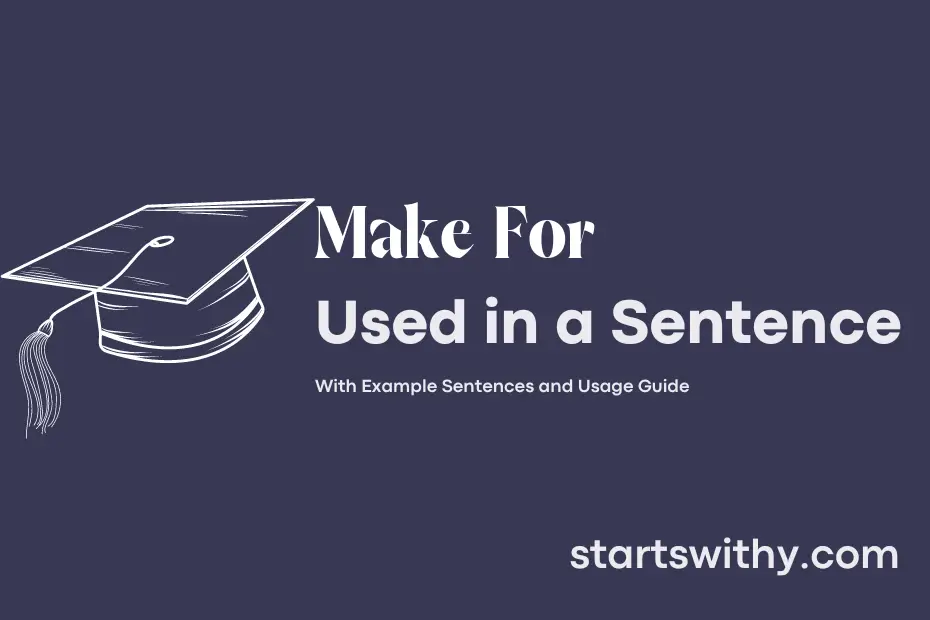Have you ever wondered how to use the phrase “make for” in English? Well, let’s delve into how this expression can be used to indicate the result or outcome of a situation.
When you use “make for” in a sentence, you are highlighting the contribution or impact that something has on a particular situation. This phrasal verb is commonly used to demonstrate how something leads to or creates a certain result.
7 Examples Of Make For Used In a Sentence For Kids
- Sunshine and fresh air make for a perfect day at the park.
- Mixing colors together can make for a beautiful painting.
- Adding milk and sugar can make for a tasty cup of tea.
- Picking flowers and arranging them make for a lovely bouquet.
- Playing with friends can make for a fun and exciting time.
- Reading a book before bed can make for sweet dreams.
- Eating fruits and vegetables make for a healthy snack.
14 Sentences with Make For Examples
- Studying regularly and staying organized can make for better exam results.
- The availability of study groups on campus can make for a more collaborative learning environment.
- Finding a part-time job can make for some extra pocket money for college students.
- Having a daily routine can make for a more balanced lifestyle for college students.
- Joining a club or student organization can make for a great way to meet new people.
- Attending career fairs can make for opportunities to network and secure internships.
- Creating a study schedule can make for more efficient time management during exams.
- Utilizing online resources can make for better research papers and projects.
- Cooking at home can make for significant savings on food expenses for college students.
- Practicing mindfulness and meditation can make for reduced stress levels during exams.
- Working on group projects can make for improved collaboration skills.
- Taking breaks during studying can make for improved retention of information.
- Attending workshops and seminars can make for enhanced skill development outside of the classroom.
- Networking with alumni can make for valuable insights into potential career paths.
How To Use Make For in Sentences?
To use “Make For” in a sentence, start by identifying the context in which you want to express the idea of cause or result.
-
Make For is often used to indicate that something leads to a particular outcome or brings about a specific result. For example, “Studying regularly will make for better grades in school.”
-
To construct a sentence using Make For, first place “Make For” before the cause or action that results in an outcome. Then, follow it with the desired consequence or result. For instance, “Eating a healthy breakfast every morning will make for a productive day ahead.”
-
Another way to use Make For is by expressing how a certain action or situation contributes to a particular purpose or objective. For example, “The new software update will make for a more user-friendly experience.”
-
Remember that Make For can also be used to convey the idea of creating conditions suitable for achieving a specific goal. For instance, “Clear communication amongst team members will make for successful project completion.”
-
Lastly, you can use Make For to describe how something results in a favorable or unfavorable situation. For example, “His lack of attention to detail will make for a problematic outcome in the presentation.”
By following these guidelines and practicing with various examples, you can effectively incorporate Make For into your sentences to convey causation, results, contributions, or conditions.
Conclusion
In conclusion, sentences with “make for” are commonly used to convey the idea of creating something or contributing to a specific outcome or result. Whether it’s making for a challenging situation, a positive experience, or a compelling argument, this phrasal verb is versatile and can be utilized in diverse contexts. By examining different examples such as “His insightful comments make for a lively discussion” or “The scenic setting makes for a relaxing vacation,” it is evident that “make for” plays a crucial role in expressing causation, impact, or suitability in English language communication.
Overall, understanding how to effectively incorporate “make for” into sentences can enhance clarity and precision in conveying intentions or describing certain scenarios. By grasping the nuances of this phrasal verb and its various meanings, individuals can skillfully construct sentences that aptly capture the intended message, making their communication more effective and engaging.



